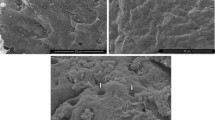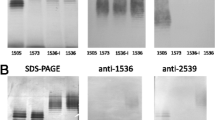Abstract
The faecal flora of patients with Crohn's disease has been found to contain higher numbers of anaerobic gram-negative rods and gram-positive coccoid rods than the flora of healthy subjects. In a considerable percentage of sera from patients with Crohn's disease, agglutinating antibodies were found against four strains of the coccoid rods, in contrast to sera from patients with ulcerative colitis, other diseases and healthy subjects.
In the present study, coccoid strains C18, Me46 and Me47 were found to activate complement by the alternative pathway. IgG antibodies to strains Me44, C18 and Me47 had opsonic properties but those to strain Me46 failed to induce phagocytosis. The data suggest an inadequate immune defence against strain Me46 in patients with Crohn's disease.
The possible role of strain Me46 in the pathogenesis of Crohn's disease is discussed.
Similar content being viewed by others
References
Bolton, R. P., Sherriff, R. J. and Read, A. E. 1980. Clostridium difficile associated diarrhoea: a role in inflammatory bowel disease. — Lancet 1980, I: 383–384.
Böyum, A. 1968. Isolation of mononuclear cells and granulocytes from human blood. — Scand. J. Clin. Lab. Invest. suppl. 97.
Bryan, C. S. 1974. Sensitization of E. coli to the serum bactericidal system and to lysozyme by ethyleneglycoltetraacetic acid. — Proc. Soc. Exp. Biol. Med. 145: 1431–1433.
Fine, D. P. 1977. Comparison of ethyleneglycoltetraacetic acid and its magnesium salt as reagent for studying alternative complement pathway function. — Infect. Immun. 16: 124–128.
Frank, M. M. 1979. The complement system in host defense and inflammation. — Rev. Infect. Dis. 1: 483–501.
Fudenberg, H. H., Pink, J. R. L., An Chuan Wang and Douglas, S. D. 1978. Basic immunogenetics. — Oxford University Press, New York.
Lake, A. M., Stitzel, A. E., Urmson, J. R., Walker, W. A. and Spitzer, R. E. 1979. Complement alterations in inflammatory bowel disease. — Gastroenterology 76: 1374–1379.
Kirsner, J. B. 1975. Problems in the differentiation of ulcerative colitis and Crohn's disease of the colon: the need for repeated diagnostic evaluation. — Gastroenterology 68: 187–191.
Lennard-Jones, J. E., Lockhart-Mummery, H. E. and Morson, B. C. 1968. Clinical and pathological differentiation of Crohn's disease and proctocolitis. — Gastroenterology 54: 1162–1170.
McConnell, R. B. 1972. Genetics of Crohn's disease. — Clinics in Gastroenterology 1: 321–334.
Van de Merwe, J. P. 1980. Serum antibodies to anaerobic coccoid rods in Crohn's disease. Thesis Rotterdam.
Van de Merwe, J. P., Lindemans, J. and Mol, G. J. J. 1980. Plasma lysozyme levels and decay of neutrophilic granulocytes in patients with Crohn's disease. — Hepato-Gastroenterol. 27: 130–134.
Van de Merwe, J. P., Schmitz, P. I. M. and Wensinck, F. 1980. Antibodies to Eubacterium and Peptostreptococcus and the estimated probability of Crohn's disease. — Submitted for publication.
Meyers, M. A., Alonso, D. R., Morson, B. C. and Bartram, C. 1978. Pathogenesis of diverticulitis complicating granulomatous colitis. — Gastroenterology 74: 24–31.
Natvig, J. B. and Kunkel, H. G. 1973. Human immunoglobulins: classes, subclasses, genetic variants, and idiotypes. — Adv. Immunol. 16: 1–59.
Steffelaar, J. W., Graaff-Reitsma, C. B. and Feltkamp-Vroom, T. M. 1976. Immune complex detection by immunofluorescence on peripheral blood polymorphonuclear leucocytes. — Clin. Exp. Immunol. 23: 272–278.
Thompson, R. A. 1979. Immunological mechanisms. p. 14–22. In P. Asquith (ed.), Immunology of the gastrointestinal tract. — Churchill Livingstone, Edinburgh.
Verrier Jones, J. and Cumming, R. H. 1977. Tests involving the reaction of immune complexes with complement. p. 138–142. In R. A. Thompson (ed.), Techniques in clinical immunology. —Blackwell Scientific Publ., Oxford.
Wensinck, F. 1975. The faecal flora of patients with Crohn's disease. — Antonie van Leeuwenhoek 41: 214–215.
Wensinck, F. 1976. Faecal flora of Crohn's patients. Serological differentiation between Crohn's disease and ulcerative colitis. p. 103–105. In: The management of Crohn's disease. — Excerpta Medica, Amsterdam.
Wensinck, F., Custers-van Lieshout, L. M. C., Poppelaars-Kustermans, P. A. J. and Schröder, A. M. 1980. The faecal flora of patients with Crohn's disease. — Accepted for publication in J. Hyg. (Camb.).
Wensinck, F. and Van de Merwe, J. P. 1980. Serum agglutinins to Eubacterium and Peptostreptococcus species in Crohn's and other diseases. — Accepted for publication in J. Hyg. (Camb.).
Author information
Authors and Affiliations
Rights and permissions
About this article
Cite this article
van de Merwe, J.P., Mol, G.J.J. A possible role of Eubacterium and Peptostreptococcus species in the aetiology of Crohn's disease. Antonie van Leeuwenhoek 46, 587–593 (1980). https://doi.org/10.1007/BF00394014
Received:
Issue Date:
DOI: https://doi.org/10.1007/BF00394014




